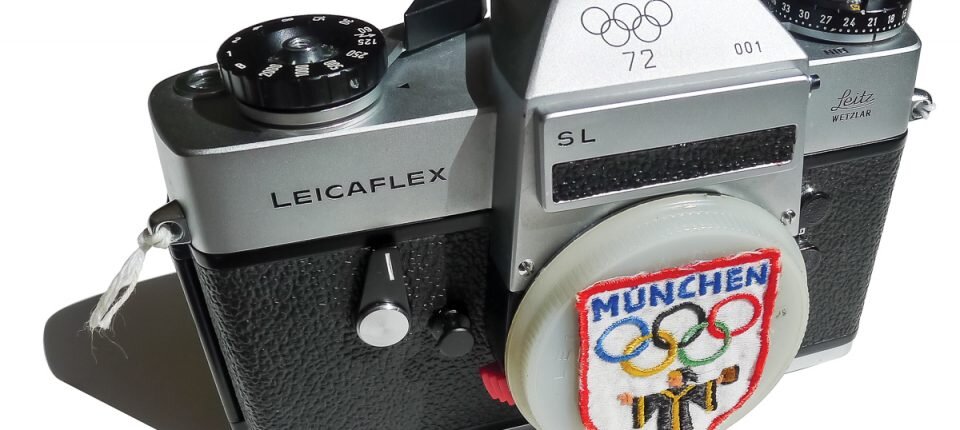An Olympic Squabble
To celebrate the 1972 Olympic Games in Munich, Ernst Leitz Wetzlar GmbH (today Leica Camera AG) issued 1000 Leicaflex SL cameras engraved with the classic logo of the five Olympic rings (figure 1: Leicaflex SL camera engraved with the Olympic rings). Special serial numbers ranging from 001 to 1000 were engraved on the prism housing of those cameras. Batches of these cameras were allotted to Leitz subsidiaries around the world and 200 of them were reserved for the American market. When they arrived at the Port of New York, however, they were promptly impounded by U.S. Customs, because the Olympic logo is a trademark and the property of each country’s Olympic Committee, and E. Leitz Inc., New York had not acquired the license to use that logo on its products. Kodak, on the other hand, had already purchased those exclusive rights for the U.S. market (figure 2: Kodak Instamatic X30 camera with Olympic sticker), and this compelled the personable Leitz New York sales manager Gene Anderegg to phone me to ask whether I could arrange a special dispensation of those rights, especially in consideration of the fact that the list price of the Kodak Instamatic X30 camera (produced from 1971 to 1974) was only $38.00, compared to $645.00 for the Leicaflex SL camera (produced from 1968 to 1974), so that it absolutely did not constitute a competition for the Kodak camera.
At the time, I was working in the International Advertising Division of Kodak, which was located only a few floors away from the Consumer Marketing Department, so I walked over to that area and asked a young member of that group if the aforementioned dispensation could be granted. To my surprise, he was adamant and commented that Leitz should have known the rules. That seemed rather arrogant to me, so I climbed the stairs a few floors higher to the office of a senior marketing executive whom I had met before and I asked him about the same dispensation. To my great relief, he promptly agreed, whereupon I asked him to put it in writing, so that I could submit a formal permission to the Leitz New York sales manager.
As a publicity stunt, Leitz Wetzlar advertising manager Hans-Günther von Zydowitz had planned to award the Leicaflex SL camera with the special number 013 to the most unlucky athlete of the 1972 Summer Olympic Games in Munich. This plan was abruptly cancelled, however, after Arab terrorists attacked the Israeli team in the Olympic village dormitories, because that gesture would have been very insensitive.
But the story doesn’t end here. When I forwarded the aforementioned agreement to Mr. Anderegg, I boldly took advantage of the opportunity and asked him to reserve the camera with the special serial number 001 for me. He grumbled and hesitated, commenting that he had planned to keep that camera for himself. But he could not refuse because I had, after all, helped to liberate the entire U.S. batch of Olympic Leicaflex SL cameras for him.
Ironically, that camera is now back in Wetzlar, where it was made originally. It was part of my collection, which Leica Camera AG has acquired to form the core of the handsome new Leica Museum. This was an ideal solution for the disposal of my collection, which began in Rio de Janeiro on 21 February 1949, when I purchased my first Leica IIIc, paying for it in 12 installments. That one I kept and I am looking at that camera as I write this article, and it still works perfectly!
figure 1: Leicaflex SL camera engraved with the Olympic rings
(figure 2: Kodak Instamatic X30 camera with Olympic sticker)

